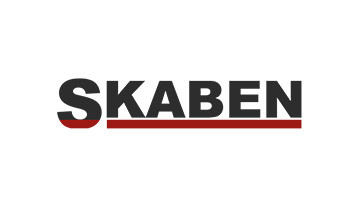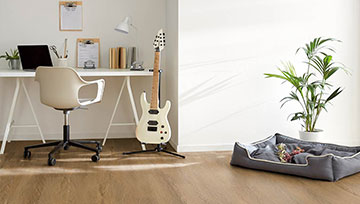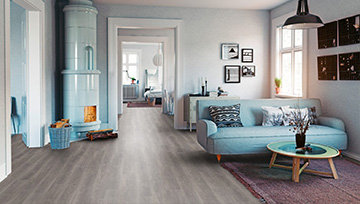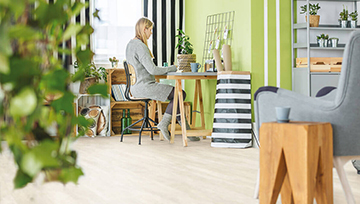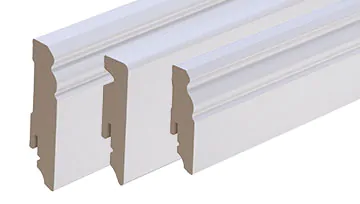Skaben organic flooring
Skaben organic flooring is an elastic floor covering made of synthetic thermoplastics. It is absolutely free of PVC. You can therefore use it in all rooms with a clear conscience. It is particularly nice that it is also suitable for laying in damp rooms such as the bathroom. Skaben offers this organic flooring in a wide range of designs - both in stone and wood look. Visually, the installed floor can hardly be distinguished from a stone or wooden floor. In addition, you can choose between different tile or plank sizes.
The advantages of this organic floor at a glance
- robust flooring
- Service class for the living area: 23
- Service class for the commercial sector: 34
- Service class in industrial environment: 43
- Warranty periods: 25 years for the living area, otherwise 10 years
- resistant surface
- easy to clean
- very quiet floor covering
- soft and elastic covering, which is therefore gentle on the joints
- always pleasantly warm to the feet
- The castors of desk chairs do not cause damage to the floor covering.
- Furniture feet do not cause damage to this floor covering.
- The floor covering is non-fading.
- The floor covering is resistant to chemicals.
- This floor covering is stain resistant
- Thermal resistance: 0.02 km²/W
- suitable for use above water-bearing floor heating systems
- suitable for installation in damp rooms
- Room air quality according to ISO 16000-9: A+
- free from plasticizers
What do the service classes mean?
The indication of the service class consists of the abbreviation NK, followed by two numbers. The first number indicates the area of use. It means 2 = use in residential areas, 3 use in commercial premises, 4 installation in industrial environments. The second number gives information about the possible load.
For the residential area this results in
- 21: moderate use, this applies, for example, to a storage room or a bedroom
- 22: normal use - for example in the living room or dining room
- 23: intensive use - for example in the hallway or kitchen
For commercial premises this results in
- 31: moderate use - for example in hotel rooms or small offices
- 32: normal use - for example in hotel lobbies
- 33: heavy use - for example in open-plan offices
- 34: intensive use - for example in classrooms or salesrooms
In the industrial environment, it looks like this:
- 41: moderate use - workshops with light traffic
- 42: normal use - for example storage rooms
- 43: heavy use - for example in production halls
What you need to consider when laying the floor covering
Before you can lay the floor covering, it must acclimatise to the room climate. To do this, lay the unopened packages flat in the room for at least 48 hours. During the acclimatisation phase and installation, the room temperature should be at least 18 °C, the floor temperature of the subfloor should not fall below 15 °C. The relative air humidity must not exceed 65%. These conditions must be maintained during the acclimatisation phase, during installation and 48 hours afterwards.
The organic floor is glued over the entire surface. It is important that the subfloor is dust-free, clean, dry, solid, level, crack-free and absorbent. With a glued floor, unevenness of the subfloor will quickly press through into the floor covering. It is therefore worthwhile to work precisely when preparing the subfloor. If you want to install the floor covering over a water-bearing underfloor heating system, this must be switched off both during installation and for 24 hours afterwards. When the heating is in operation, the surface temperature must not exceed 28 °C.
As a rule, use a dispersion adhesive for wet-bed gluing to bond the flooring. If you want to install the floor covering in damp rooms or rooms with strong sunlight, PU or contact adhesives are suitable. According to the manufacturer's instructions, spread the adhesive on the subfloor with a spatula. The tiles of the organic floor are then pressed into this bed of adhesive.


